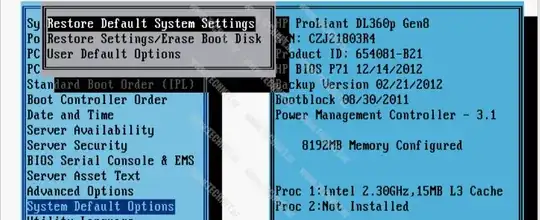I have a written a piece of multi-threaded software that does a bunch of simulations a day. This is a very CPU-intensive task, and I have been running this program on cloud services, usually on configurations like 1GB per core.
I am running CentOS 6.7, and /proc/cpuinfo gives me that my four VPS cores are 2.5GHz.
processor : 3
vendor_id : GenuineIntel
cpu family : 6
model : 63
model name : Intel(R) Xeon(R) CPU E5-2680 v3 @ 2.50GHz
stepping : 2
microcode : 1
cpu MHz : 2499.992
cache size : 30720 KB
physical id : 3
siblings : 1
core id : 0
cpu cores : 1
apicid : 3
initial apicid : 3
fpu : yes
fpu_exception : yes
cpuid level : 13
wp : yes
flags : fpu vme de pse tsc msr pae mce cx8 apic sep mtrr pge mca cmov pat pse36 clflush mmx fxsr sse sse2 ss syscall nx pdpe1gb rdtscp lm constant_tsc arch_perfmon rep_good unfair_spinlock pni pclmulqdq ssse3 fma cx16 pcid sse4_1 sse4_2 x2apic movbe popcnt tsc_deadline_timer aes xsave avx f16c rdrand hypervisor lahf_lm abm arat xsaveopt fsgsbase bmi1 avx2 smep bmi2 erms invpcid
bogomips : 4999.98
clflush size : 64
cache_alignment : 64
address sizes : 40 bits physical, 48 bits virtual
power management:
With a rise of exchange rates, my VPS started to be more expensive, and I have came to a "great deal" on used bare-metal servers.
I purchased four HP DL580 G5, with four Intel Xeon X7350s each. Basically, each machine has 16x 2.93GHz cores and 16GB, to keep things like my VPS cloud.
processor : 15
vendor_id : GenuineIntel
cpu family : 6
model : 15
model name : Intel(R) Xeon(R) CPU X7350 @ 2.93GHz
stepping : 11
microcode : 187
cpu MHz : 1600.002
cache size : 4096 KB
physical id : 6
siblings : 4
core id : 3
cpu cores : 4
apicid : 27
initial apicid : 27
fpu : yes
fpu_exception : yes
cpuid level : 10
wp : yes
flags : fpu vme de pse tsc msr pae mce cx8 apic mtrr pge mca cmov pat pse36 clflush dts acpi mmx fxsr sse sse2 ss ht tm pbe syscall lm constant_tsc arch_perfmon pebs bts rep_good aperfmperf pni dtes64 monitor ds_cpl vmx est tm2 ssse3 cx16 xtpr pdcm dca lahf_lm dts tpr_shadow vnmi flexpriority
bogomips : 5866.96
clflush size : 64
cache_alignment : 64
address sizes : 40 bits physical, 48 bits virtual
power management:
Essentially it seemed a great deal, as I could stop using VPS's to perform these batch works. Now it is the weird stuff...
- On the VPS's I have been running 1.25 thread per core, just like I have been doing on the bare metal. (The extra 0.25 thread is to compensate idle time caused by network use.)
- On my VPS, using in total 44x 2.5GHz cores, I get nearly 900 simulations per minute.
- On my DL580, using in total 64x 2.93GHz cores, I am only getting 300 simulations per minute.
I understand the DL580 has an older processor. But if I am running one thread per core, and the bare metal server has a faster core, why is it performing poorer than my VPS?
I have no memory swap happening in any of the servers.
TOP says my processors are running at 100%. I get an average load of 18 (5 on VPS).
Is this going to be this way, or am I missing something?
Running lscpu gives me 1.6GHz on my bare metal server. This was seen on the /proc/cpuinfo as well.
Is this information correct, or is it linked to some incorrect power management?
[BARE METAL] $ lscpu
Architecture: x86_64
CPU op-mode(s): 32-bit, 64-bit
Byte Order: Little Endian
CPU(s): 16
On-line CPU(s) list: 0-15
Thread(s) per core: 1
Core(s) per socket: 4
Socket(s): 4
NUMA node(s): 1
Vendor ID: GenuineIntel
CPU family: 6
Model: 15
Stepping: 11
**CPU MHz: 1600.002**
BogoMIPS: 5984.30
Virtualization: VT-x
L1d cache: 32K
L1i cache: 32K
L2 cache: 4096K
NUMA node0 CPU(s): 0-15
[VPS] $ lscpu
Architecture: x86_64
CPU op-mode(s): 32-bit, 64-bit
Byte Order: Little Endian
CPU(s): 4
On-line CPU(s) list: 0-3
Thread(s) per core: 1
Core(s) per socket: 1
Socket(s): 4
NUMA node(s): 1
Vendor ID: GenuineIntel
CPU family: 6
Model: 63
Stepping: 2
**CPU MHz: 2499.992**
BogoMIPS: 4999.98
Hypervisor vendor: KVM
Virtualization type: full
L1d cache: 32K
L1i cache: 32K
L2 cache: 256K
L3 cache: 30720K
NUMA node0 CPU(s): 0-3
